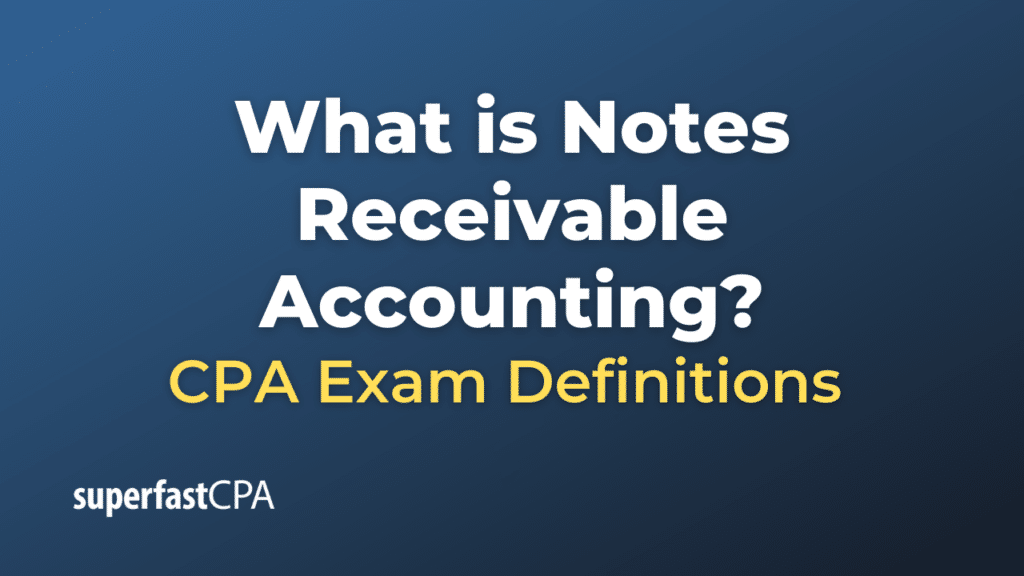Notes Receivable Accounting
Notes receivable accounting involves the recording and tracking of promissory notes that a company receives. A note receivable is a written promise by a customer or another party to pay a certain amount of money to the company at a specific future date, usually with interest.
The accounting for notes receivable involves several steps:
- Recognition of the Note: When a company receives a promissory note, it records it as an asset on its balance sheet. The note is typically recorded at its face value (the principal amount the issuer has promised to pay).
For example, if a customer issues a $10,000 note to a company, the company would debit (increase) Notes Receivable for $10,000 and credit (decrease) Accounts Receivable (if the note was issued to replace an existing account receivable), or credit Sales Revenue (if the note was issued for a sale) for $10,000. - Accrual of Interest: Over the life of the note, the company accrues interest revenue. This is typically done at the end of each accounting period.
For instance, if the $10,000 note carries a 5% annual interest rate and three months have passed, the company would debit (increase) Interest Receivable for $125 ($10,000 x 5% x 3/12) and credit (increase) Interest Revenue for $125. - Collection of the Note: When the note is due and the issuer pays it, the company records the receipt of the cash. This involves debiting (increasing) Cash for the amount received, crediting (decreasing) Notes Receivable for the face value of the note, and crediting (decreasing) Interest Receivable and crediting (increasing) Interest Revenue for any accrued interest.
So, if the $10,000 note is paid in full at the end of the year, along with $500 in interest ($10,000 x 5%), the company would debit Cash for $10,500, credit Notes Receivable for $10,000, and credit Interest Revenue for $500.
The exact entries can vary depending on the specific terms of the note and the company’s accounting policies. However, this process provides a general idea of how notes receivable accounting works.
Example of Notes Receivable Accounting
Let’s say a company named ABC Corp. provides consulting services to a client, XYZ Ltd. At the end of the month, XYZ Ltd. is unable to pay the $10,000 invoice due to temporary cash flow issues. Instead, XYZ Ltd. issues a 1-year promissory note to ABC Corp. for $10,000 with an annual interest rate of 5%.
Here’s how ABC Corp. would account for this note:
1. Recognition of the Note: ABC Corp. would remove the amount from Accounts Receivable and recognize it as a Note Receivable.
The journal entry would be:
- Debit (increase) Notes Receivable $10,000
- Credit (decrease) Accounts Receivable $10,000
This entry recognizes the conversion of the receivable to a note.
2. Accrual of Interest: At the end of each accounting period (for simplicity, let’s say annually), ABC Corp. would accrue the interest on the note.
The journal entry after one year would be:
- Debit (increase) Interest Receivable $500 ($10,000 * 5%)
- Credit (increase) Interest Revenue $500
This entry records the interest that ABC Corp. has earned but not yet received.
3. Collection of the Note: At the end of the note’s term (1 year later), when XYZ Ltd. pays back the principal and interest, ABC Corp. would record the collection.
The journal entry would be:
- Debit (increase) Cash $10,500 ($10,000 principal + $500 interest)
- Credit (decrease) Notes Receivable $10,000
- Credit (decrease) Interest Receivable $500
This entry records the collection of the note principal and the interest.
By following this process, ABC Corp. accurately records the issuance, interest accrual, and collection of the note receivable.













